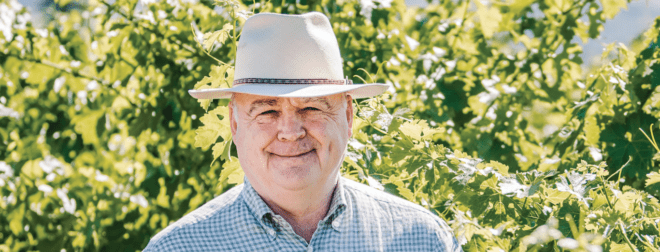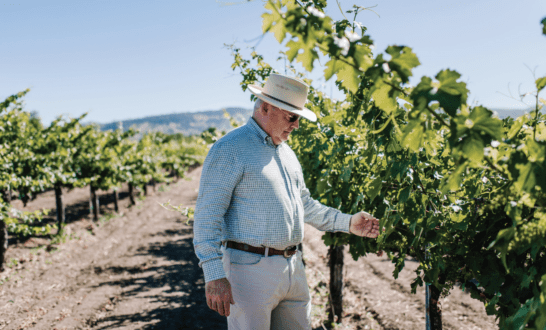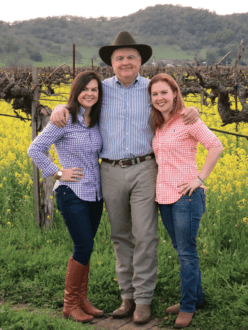

Nov 15, 2019Napa grower’s enterprise, sustainability efforts honored
A career of enterprise and advocating for sustainable growing led to Andrew Hoxsey being named Grower of the Year.
Hoxsey, a fourth-generation grower, and part owner of Yount Mill Vineyards, Yountville, California, and Napa Wine Co. in Oakville, is credited for his work on the California Sustainable Winegrowing Alliance in its formative years, and also for launching the Napa Valley’s first custom-crush operation, which gives winegrape growers more options for their crop.
The Grower of the Year award is the highest award bestowed by the California Association of Winegrape Growers (CAWG). It recognizes an “efficient and successful producer of quality winegrapes” who is a leader and innovator in the industry.
“Over a period of three decades, Andy has exemplified the best in grape growing with his commitment to sustainable winegrowing, agricultural preservation, habitat restoration and conservation,” CAWG President John Aguirre said.
Custom crushes
Napa Valley growers also know Hoxsey for his role in establishing the Napa Wine Co. The company was formed in 1993 when the Pelissa family – Andrew’s mother’s side, which is associated with the vineyards – bought a historical Oakville winery.
In the 1970s and early ’80s, there were only six places outside of the cooperative that a grower could sell grapes to, he said. It seemed like the smaller winemakers were spending all of their money on new tanks and winemaking equipment to increase their ability to make low-margin wines.
“I felt there was a need to nurture smaller wineries,” Hoxsey said. “The rising tide raises all boats.”
Several successful wineries have grown after getting a start at the custom facility, he said. The facility crushes 8,000 tons a year and bottles 1 million cases.
“We’re still selling 90% of our fruit to other people,” he said. “But the good news is, being a little more vertically integrated, if a sale falls through or if for whatever reason a customer can’t use the fruit, we have the ability to bring it to our facility, crush it, make it into wine and then bulk it out if we need to.
“You can imagine a farmer’s dilemma when it’s within two days of needing to be harvested and you don’t have a home (for the fruit).”


A sustainable future
Hoxsey, a fourth-generation grower, learned about winegrape growing early on from his grandfather, Andrew Pelissa, and longtime ranch hand and family friend Andrew DelBondio. He later graduated from the University of California-Davis with a degree in agricultural economics and business management.
As Hoxsey grew up, Napa County was starting to learn about sustainability.
“We saw what was happening around San Jose, in Stanford and places like that. That is called the Santa Clara Valley,” he said. “It was probably the most productive peach and orchard-growing area in the entire planet at one point in time. It was just a fabulous area for a variety of crops. And it didn’t take 10 years to just completely chop up all that farm ground for (hardware and software company) Apple campuses and Silicon Valley – it’s not even called Santa Clara Valley anymore. And I don’t think it would have happened quite as rapidly if our property tax laws weren’t the way they were in those days.”
Napa County in 1968 established an agricultural preserve district that established a 40-acre minimum lot size.


“This county will be in agriculture in perpetuity, given that set of laws,” Hoxsey said. “Given that we’re so close to the San Francisco Bay area it would be pretty easy to chop up your vineyards for the houses.”
After college, and spending several years as a pilot in the Air Force, Hoxsey happily returned in the mid1980s to the family farm.
Yount Mill Vineyards was organically certified in the 1980s. Working with the American Vineyard Foundation, Hoxsey did his best to encourage organic research.
“The American Vineyard Foundation was very far looking ahead at, what is the research that people want done,” Hoxsey said. “Some of our donors could specifically say, ‘I want my dollars to go towards organic projects.’”
That work eventually led to talks with other winegrape growers about sustainable farm practices.
“Because of being on CAWG, because of being an organic grower, and because of being on the research side of things, CAWG sent me to be one of the founding directors of the California Sustainable Winegrowing Alliance (CSWA),” Hoxsey said. “We had this mantra that a viable business is a three-legged stool. It’s profitable, so economically viable. It’s socially just, treats its employees well; they have health insurance, etc. It’s environmentally sensitive to the issues around it, erosion and chemical use and water draft down and things like that.”
One of the CSWA’s accomplishments was a thick workbook, still in use today, that guides growers through sustainable practices.
“The questions are multiple: Do you cover crop? Do you mow? Do you clean-till? And then depending on your answers, it will give you thoughts on how to improve your practices to be a little more sustainable. It’ll talk about electricity use, water use, even chemical use, mildew prevention use, bug prevention.” Hoxsey said. “There’s no issue that you can’t find something in the workbook that asks you, ‘What are you currently doing?’ and ‘This is how you might be able to improve your operation.’”
Yount Mill Vineyards practices clean tillage, and produces its own compost from grape seeds, skins and other inputs like straw from horse bedding, which helps to give the compost a “backbone.” The farm is also experimenting with BioFiltro, a system for naturally filtering water while creating compost.
Hoxsey said he’s no longer very active in the industry associations, but it’s a privilege to see his children coming into leadership roles.
“I’m actively trying to mentor my children, so the fifth generation is becoming much more active day-today. One daughter is in the vineyard right now; another daughter is in Houston selling wine, so we certainly hope that it goes into the future for a few more generations.”
— Stephen Kloosterman, associate editor; top photo: Joanna Salazar/Snapped With Love Photography














